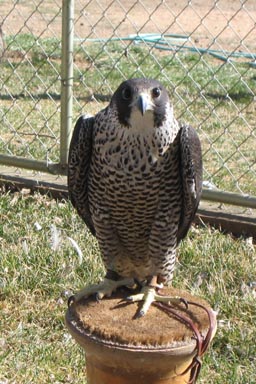|
| 질의: Ocean world | 결과: 420번째/491 | |
Peale's Falcon (Falco peregrinus pealei) - Wiki
| 제목: | Peale's Falcon (Falco peregrinus pealei) - Wiki
| |

| 해상도: 256x384
파일크기: 38220 Bytes
등록시간: 2007:12:06 17:02:10
|
Peale's Falcon
From Wikipedia, the free encyclopedia
Order: Falconiformes
Family: Falconidae
Species: Falco peregrinus (Peregrine Falcon)
[Photo] Peale's Falcon (Falco peregrinus pealei) captive female. Photo by http://en.wikipedia.org/wiki/User:Mtfalconer | Permission is granted to copy, distribute and/or modify this document under the terms of the GNU Free Documentation License, Version 1.2 or any later version published by the Free Software Foundation; with no Invariant Sections, no Front-Cover Texts, and no Back-Cover Texts. A copy of the license is included in the section entitled "GNU Free Documentation License". |
The Peale's Falcon Falco peregrinus pealei is a subspecies of the Peregrine Falcon. This race was first identified by the ornithologist Robert Ridgway in 1873. These birds are the largest subspecies of Peregrines (on average) anywhere in the world. The adults are generally identified by the presence of heavy horizontal barring across their abdomen, large "tear-drop" shaped markings on their breast (more conspicuous in the females), a white or smokey-white background on the breast (as opposed to the salmon wash on most other subspecies), and wider, stronger mandibles (beak) than is commonly seen in the species as a whole.
Distribution and Habitat
This subspecies is thought of as one of the least migratory of all races of Peregrines. They are found from the Puget Sound region of Washington north, along the British Columbia Coast (including the Queen Charlotte Islands and Vancouver Island), around the the Gulf of Alaska and into the Cook Inlet. From their they extend southwestward along the Alaska Peninsula and are found on Kodiak Island. This area constitues their eastern range which shows slightly different morphology, which is generally credited to being exposed to Falco peregrinus anatum genes, especially in the extreme southeastern portion of this range. This intra-specific subspecies hybridization can be seen in the Peale's as a diluted salmon colored breast, smaller size, narrower wing, and just a generally slender appearance as opposed to the short, stocky appearance of the pure Peale's.
From the Shumagin Islands westward along the Aleutian Islands to the Commander Islands resides the ultra-typical Peale's, being of broader wing, lighter wing-loading, and even more sedentary than their eastern counterparts.
Specifically within this range, the Peale's Falcon is found on rough, rocky seashores. Ocean cliffs, seastacks, islands, beaches, and out to 50 miles from shore this bird can be found flying or sitting and watching for its next meal.
Hunting and Food Habits
The Peale's falcon is known to concentrate its hunting efforts on Alcids. In fact the subspecies is well known to nest very near shorebird colonies for the convenience of close hunting grounds.
http://en.wikipedia.org/wiki/Peale's_Falcon
| The text in this page is based on the copyrighted Wikipedia article shown in above URL. It is used under the GNU Free Documentation License. You may redistribute it, verbatim or modified, providing that you comply with the terms of the GFDL. |
|
^o^
동물그림창고 똑똑전화 누리집
^o^
|
|